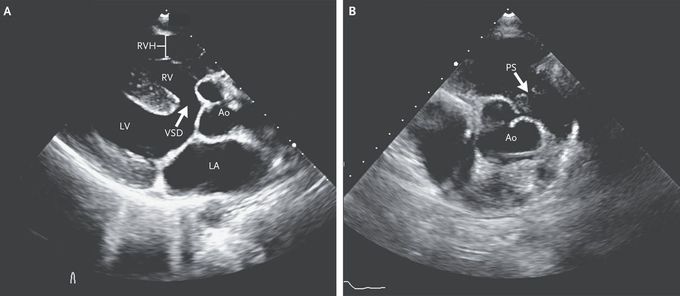


Unrepaired Tetralogy of Fallot in Adulthood
A 29-year-old man who had recently immigrated to the United States presented to the cardiology clinic with worsening exertional dyspnea, visual blurring, and headaches. These symptoms had been present since childhood, but he had not received regular medical care and the condition had not been diagnosed. The patient had found that his symptoms lessened when he squatted or after 30 minutes of rest. The oxygen saturation was 92% while the patient was breathing ambient air. The physical examination was notable for a harsh holosystolic murmur at the left sternal border (listen to audio) with a sternal heave. There was no evidence of digital clubbing. Electrocardiography showed sinus rhythm with a right bundle-branch block. Laboratory studies showed a hemoglobin level of 20 g per deciliter (reference range, 13 to 17). Echocardiography (Panel A) showed the aorta (Ao) overriding a large ventricular septal defect (VSD) and right ventricular hypertrophy (RVH), along with subpulmonic stenosis (PS) (Panel B), all of which confirmed the diagnosis of tetralogy of Fallot. The characteristic murmur is due to right ventricular outflow obstruction. Squatting maneuvers increase systemic vascular resistance, resulting in reversal of shunting at the ventricular septal defect and therefore a reduction in symptoms. The patient underwent surgical repair including pulmonary valvotomy, closure of the septal defect, resection of muscle bundles in the right ventricular outflow tract, and patch augmentation of the infundibulum and main pulmonary artery. Two months later, he was recovering well without further episodes of dyspnea, visual disturbance, or headache.

